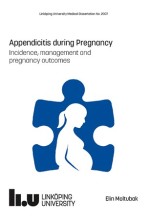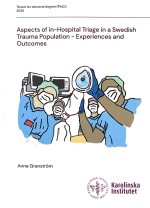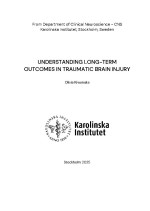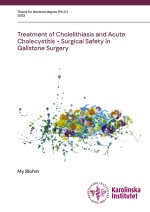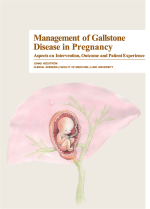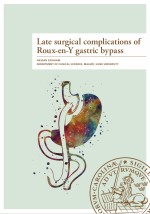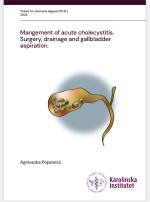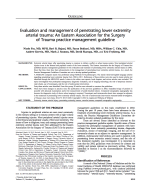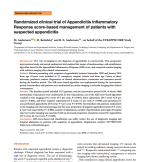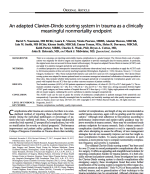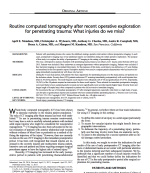Utvalda avhandlingar och artiklar
Utvalda avhandlingar och artiklar
För stimulera våra medlemmar att ta del av tillgänglig litteratur och nya vetenskapliga artiklar kommer styrelsen fortlöpande lägga ut sådant som vi tycker borde lyftas fram. Bör ses som ett komplement till övriga litteraturstudier och speglar våra subjektiva val av vad som är läsvärt. Med det sagt, här kommer några förslag!
Avhandling: Appendicitis during Pregnancy
Elin Moltubak
Background: Appendicitis during pregnancy is rare but still the most common reason for non-obstetric surgery during pregnancy. Evidence on incidence patterns across gestation,
pregnancy outcomes, and management is limited and often methodologically heterogeneous. The overall aims were to investigate the incidence and management of suspected appendicitis during pregnancy, and to assess pregnancy outcomes following appendicitis and/or appendectomy.
Methods: Papers I–II are nationwide, register-based cohort studies using the Swedish Medical Birth Register and National Patient Register (1973–2013/2023).The incidence of appendicitis across pregnancy trimesters and during the intervals one year before and two years after pregnancy was estimated and reported as incidence rates (IR) and standardized incidence ratios (SIR). Outcomes included IUFD, preterm birth, cesarean section, Apgar <7 at 5 minutes, SGA and neonatal mortality. Paper II additionally used matched case–control analyses by gestational age at exposure to estimate odds ratios for outcomes. Paper III is a nested case–control study (2010–2013) of pregnant patients undergoing appendectomy or admitted with nonspecific abdominal pain, evaluating diagnostic imaging and the AIR score (discrimination by AUC; sensitivity/specificity thresholds). Paper IV is a randomized, single-blind national survey of on-call surgeons (spring 2025) using parallel case scenarios (pregnant vs non-pregnant), with primary outcomes of management choices and adherence to AIR-based recommendations; TFA and PRA scales were included evaluating personality traits linked to tolerance for uncertainty and risk attitude among surgeons.
Main Results: Incidence of appendicitis was markedly lower during pregnancy, especially in the third trimester, followed by a peripartum spike and a postpartum elevation that normalized within two years. In 1973–2023 data, appendicitis/appendectomy during pregnancy was associated with moderate increased risks of preterm birth (overall OR ~1.9), cesarean delivery (OR ~1.6), low 5-minute Apgar, and neonatal mortality, but not IUFD or SGA. Risks rose steeply with advancing gestational age at exposure; at 32–36 weeks, preterm birth reached 43.1% (aOR 9.84, 95% CI 8.21–11.80). Early-pregnancy surgery was not associated with excess preterm risk after adjustment, whereas late-pregnancy surgery and conservative management were. Synchronous cesarean and appendectomy increased with gestation. The AIR score performed well in pregnancy (AUC 0.88–0.90); sensitivity for complicated appendicitis was 100% at ≥4 points and specificity for any appendicitis 97% at ≥9. Imaging (mainly US) showed limited performance (sensitivity 45%, specificity 42%).
In randomized questionnaires with clinical case scenarios (response rate 41.5%, n=370),
pregnancy status shifted surgeons decisions toward observation/imaging in low–
intermediate probability scenarios and greater preference for open surgery in high
probability. Pregnancy and the reported use of a clinical score were independently
associated to adherence to AIR-based recommendations in the intermediate probability
case scenario. Clinical experience but not TFA or PRA scores were associated with
management preferences.
Conclusions: Pregnancy appears transiently protective against appendicitis, yet
appendicitis in late gestation is linked to substantially increased obstetric intervention and
preterm birth—at least partly iatrogenic through synchronous delivery. Structured clinical
assessment remains valid in pregnancy; the AIR score reliably stratifies risk, whereas
ixroutine imaging performance is limited. Management strategies should be tailored to
gestational age, judicious use of imaging, and adherence to validated clinical algorithms.
These findings support the need for gestation-specific guidelines and pathways to balance
Länk till avhandling
ASPECTS OF IN-HOSPITAL TRIAGE IN A SWEDISH TRAUMA POPULATION-EXPERIENCES AND OUTCOMES
Anna Katarina Granström
Department of Clinical Science and Education,
Södersjukhuset - KISÖS
Karolinska Institutet, Stockholm, Sweden
Early and accurate prioritization of trauma patients, known as triage, is crucial to identify those in need of emergency life-saving interventions. Excellent trauma care relies strongly on correct triage, which impacts patients' experiences and outcomes. Undertriage has been shown to be associated with an elevated risk of undetected injuries and missed interventions. However, the definition of severe trauma is still debatable. This thesis aimed to study aspects and consequences of in-hospital triage, examine over-and undertriage, trauma care processes, experiences and outcomes, providing insights to improve care for this patient group. Qualitative and quantitative approaches were used. Paper I was a 'before and after' study where the effect of a criteria-directed protocol for in-hospital triage of trauma patients in a Swedish trauma center was evaluated. The results showed that by using the protocol, overtriage was reduced from 74% to 58% while undertriage increased from 7% to 10%. No preventable deaths were detected after peer-review of those undertriaged. In Paper II, trauma patients' experiences after initial trauma management were explored, using individual face-to-face semi-structured interviews. The interviews were recorded, transcribed and analyzed using qualitative content analysis. Patients reported emotional responses to the trauma, physical discomfort and feeling prioritized or being ignored by the trauma team. The main category that emerged was: "Feeling safe in a frightening situation". In Paper III, the two scoring systems, the anatomic New Injury Severity score (NISS) and the physiology-based GAP score, for prediction on ICU-admission and 30-day mortality after trauma, were evaluated: in the Swedish trauma population. The findings showed that the GAP- score was better at predicting 30-day mortality compared to NISS, with AUROC (95% CI) values of 0.92 (0.91-0.93) and 0.84 (0.83-0.85) respectively, while NISS performed better than GAP at predicting ICU-admission. Both scoring systems were less accurate in predicting mortality in the older patient group. In Paper IV, undertriaged trauma patients were characterized and compared to non- undertriaged trauma patients, in age groups, to investigate potential differences in trauma care processes and 30-day mortality. The study results showed that undertriaged patients had fewer intubations, longer time to CT-scan and fewer admissions to ICU, were less severely injured, and had lower mortality compared to non- undertriaged patients. This demonstrates that undertriage was not associated with poorer outcomes compared to non-undertriage, in the current study.
Avhandling som PDF
UNDERSTANDING LONG-TERM OUTCOMES IN TRAUMATIC INJURY
Olivia Kiwanuka
Department of Clinical Neuroscience - CNS
Karolinska Institutet, Stockholm, Sweden
Traumatic brain injury (TBI) is a complex and impactful medical condition, capable of altering the life of a patient long after the initial trauma. This thesis strives to increase our understanding of long-term outcomes following TBI, from mild to severe cases. The studies aimed to explore predictive factors that influence patient recovery and to evaluate potential treatments targeting the chronic neuroinflammation that follows such injuries.
The research project started with an experimental study (Study I) using a rodent model to assess the chronic inflammatory response after a penetrating brain injury. We employed a treatment known as Resolvin D1, a lipid mediator derived from omega-3 fatty acids, hypothesized to aid in resolving inflammation and promoting tissue repair. Although results did not show significant changes in inflammation levels or tissue loss between treated and control groups, the study provided important insights into the timeline and complexities of chronic inflammation in TBI.
In the clinical studies (Studies II-IV), we examined data from trauma registries to evaluate patient outcomes following TBI. One key focus was the relationship between pre-injury health, as measured by the American Society of Anesthesiologists (ASA) score, and patient outcomes. The ASA-score is based on the burden of comorbidities and rates a patient's overall health status.
The second study (first clinical study) explored health-related quality of life (HRQoL) two years post-TBI, an often overlooked aspect of recovery. Using tools like the RAND-36 and EQ-5D questionnaires, we assessed how 170 trauma patients perceived their physical, emotional, and social health over the long term. Interestingly, we found that TBI patients sometimes reported better HRQoL outcomes than those who experienced non-TBI (NTBI) trauma, particularly in physical functioning and daily role limitations. This could be attributed to factors such as cognitive biases, reduced expectations due to aging, or an impaired ability to fully recognize deficits after brain injury. A high ASA-score (indicating worse health before the injury) was strongly associated with a reduced HRQoL in both the TBI and NTBI cohort. Increased injury severity, measured with the head value of the abbreviated injury score (AIS), showed a trend to association with lower HRQoL, but this was not statistically significant. We found no difference in symptoms of depression, assessed with the self-assessed Montgomary-Åsberg depression score (MADRS-S), between any of the groups.
In the third study, we included 823 trauma patients and examined 90-day mortality after mild TBI with intracranial findings (complicated mTBI) compared to NTBI. We found ASA-score to be strongly associated with higher mortality rates, independent from age and injury severity, an association we did not see in the NTBI cohort. This difference could be either due to a treatment bias and under-triage of mTBI patients, a selection bias excluding frail NTBI patients, or that the ASA-score captures an important vulnerability in mTBI patients. AIS (head) was not independently associated with mortality. We also tested the predictive value of the Trauma and Injury Severity Score (TRISS). The accuracy of TRISS was very low, which suggests that this score is not useful in milder trauma.
In the fourth and final study we tested the added value of ASA-score to the well- established International Mission for Prognosis and Analysis of Clinical Trials in TBI (IMPACT) model, on a cohort of 720 patients with moderate to severe TBI (msTBI). Here we confirmed a strong and independent association between ASA-score and both 90-day mortality and 1-year functional outcome (measured with Glasgow Outcome Score). The inclusion of ASA-scoring yielded a significantly increased estimated explained variance of the already comprehensive IMPACT model. Patients with an ASA-score of 3 or above had a pronounced increase in mortality compared to healthier individuals, which held true even in younger patients. In this cohort, TRISS proved to be strongly associated with GOS, and even more to mortality, highlighting the importance of the overall burden of injury.
While these studies provided valuable insights, limitations such as the lack of baseline HRQoL data and the challenges in differentiating chronic inflammation types in experimental models point to avenues for future research. The findings stress the necessity of early and tailored interventions to improve long-term outcomes and reinforce the importance of considering a patient's overall health in management and outcome prediction.
By investigating both the biological underpinnings and clinical outcomes of TBI, this work aims to contribute to more refined and effective approaches to treatment and rehabilitation. Understanding these long-term trajectories can enhance care protocols, allowing for a more personalised approach that accounts for individual health profiles, ultimately improving patient outcomes and quality of life following TBI.
Avhandling som PDF
TREATMENT OF CHOLELITHIASIS AND ACUTE CHOLECYSTITIS
SURGICAL SAFETY IN GALLSTONE SURGERY
My Blohm
Department of Clinical Science, Intervention and Technology, Division of Surgery, Karolinska Institutet, Stockholm, Sweden
Den 8/12 2023 disputerade My Blohm på avhandlingen “Treatment of cholelithiasis and acute cholecystitits - Surgical safety in gallstone surgery”
Huvudhandledare var Johanna Österberg och opponent Frederik Helgstrand, Köpenhamns Universitet.
Avhandlingen består av 5 delarbeten varav 3 är baserade på Gallriks och 2 är prospektiva. Arbetena är av stort kliniskt värde för den akuta gallkirurgin.
I. The Sooner, the Better? The importance of Optimal Timing of
Cholecystectomy in Acute Cholecystitis: Data from the National Swedish
Registry for Gallstone Surgery, GallRiks
My Blohm et al - J Gastrointest Surg. 2017;21(1):33-40
Fördelar rapporteras att tidigt operera patienter med cholecystit.
II. Relationship between surgical volume and outcomes in elective and acute
cholecystectomy: nationwide, observational study
My Blohm et al - Br J Surg. 2023;110(3):353-61.
Ju större operationsvolym en klinik har desto bättre resultat.
III. Differences in Cholecystectomy Outcomes and Operating Time Between
Male and Female Surgeons in Sweden
My Blohm et al - JAMA surgery. Published online August 30, 2023
Kvinnliga kirurger tar lite längre tid på sig vid operation och har färre komplikationer.
IV.Learning by doing: an observational study of the learning curve for
ultrasonic fundus-first dissection in elective cholecystectomy
My Blohm et al- Surg Endosc. 2022;36(6):4602-13
Relativt snabbt lärde sig kirurger fundus-first teknik.
V. Ultrasonic dissection in laparoscopic cholecystectomy for acute
cholecystitis, a randomized controlled trial
My Blohm et al Manuscript
Fördelar sågs med Ultraljudsdissektorn vid laparoskopisk cholecystektomi.
Vi gratulerar My och kirurgkliniken i Mora för ett fint arbete. Speciellt arbete 3 har rönt stor uppmärksamhet inte minst internationellt!
Avhandling som PDF
Management of Gallstone Disease in Pregnancy. Aspects on Intervention, Outcome and Patient Experience
Jonas Hedström
Department of Clinical Sciences, Malmö | Lund University, Sweden
This thesis aims to further contribute to the knowledge of managing gallstone disease during pregnancy.
Avhandling som PDF
Late surgical complications of Roux-en-Y gastric bypass
Hassan Zaigham
Department of Clinical Sciences, Faculty of Medicine, Lund University, Sweden
The aim of this thesis is to investigate challenges in diagnosing and managing late surgical complications of Roux-en-Y gastric bypass (RYGB) experienced by acute care surgeons.
Avhandling som PDF
Mangement of acute cholecystitis. Surgery, drainage and gallbladder aspiration
Agnieszka Popowicz
Department of Clinical Science, Intervention and Technology, Division of Surgery Karolinska Institute, Stockholm, Sweden
We found that safety of cholecystectomy increases if performed more than 30 days after discharge after a conservatively treated cholecystitis. PGBA seems to be a safe treatment option in high-risk patients, although it should be evaluated in larger studies. A cholecystostomy can be safely removed early and performing a cholangiography does not seem to change the outcome.
Avhandling som PDF
Evaluation and management of penetrating lower extremity arterial trauma
There have been changes in practice since the publication of the previous guidelines in 2002. Expedited triage of patients is possible with physical examination and/or the measurement of ankle-brachial indices. Computed tomographic angiography has become the diagnostic study of choice when imaging is required. Tourniquets and intravascular shunts have emerged as adjuncts in the treatment of penetrating lower extremity arterial trauma. The role of endovascular intervention warrants further investigation.
Abstract på PubMed
Randomized clinical trial of Appendicitis Inflammatory Response score-based management of patients with suspected appendicitis
AIR score-based risk classification can safely reduce the use of diagnostic imaging and hospital admissions in patients with suspicion of appendicitis.
Abstract på PubMed
An adapted Clavien-Dindo scoring system in trauma as a clinically meaningful nonmortality endpoint.
The ACDiT scale can be used to grade the severity of posttrauma complications in patients managed both operatively and nonoperatively. It provides clinically meaningful data for morbidity and mortality meetings and other quality improvement exercises.
Abstract på PubMed
Routine computed tomography after recent operative exploration for penetrating trauma: What injuries do we miss?
We recommend the use of immediate postoperative CT after emergent laparotomy especially when there is a high index of suspicion for spine or genitourinary injuries and in patients who have sustained ballistic penetrating injuries.
Abstract på PubMed

